
Ionoscatter on 50 and 144 MHz
Palle Preben-Hansen, OZ1RH
If you are you an experienced DX'er you know that you can use troposcatter to work stations 5-800 km away on VHF/UHF/SHF regardless of band conditions. Scatter can also take place in the ionosphere. Ionoscatter is most often caused by scattering from irregularities in the ionosphere at 65-85 km of height giving QSO's at app. 1.000-2.000 km. In this lecture ionoscatter is examined closer in order to evaluate its possibilities for QSO’s on 50 and 144 MHz.
Contents:
Preface
*Definition of ionoscatter
*Commercial use of ionoscatter
*Traditional ionoscatter - DX on 50 MHz anytime!
*Path loss, expected minimum and maximum range of your station
*Reliability and power saving
*Noise level
*Radiation angle, height of the scattering media
*Polarization
*Diurnal variations of signal strength
*Fading
*Optimum frequency
*Ionospheric disturbances
*Ionoscatter on 144 MHz
*Possible sources of enhanced ionoscatter seen by radioamateurs on 144 MHz
*Polar Mesosphere Summer Echoes, PMSE
*Radiation angle, ground reflection and ground gain
*Flat Ground
*Sloping ground
*Calculation of the radiation angle
*Signal quality
*Sources with info on the current status of the ionosphere
*Conclusion
*Literature
*
Target group:
Experienced DX’ers on 50 or 144 MHz who would like to know how ionoscatter can be used to provide QSO’s at 1.000-2.300 km.
Objectives:
After the lesson the participants should:
- know about ionoscatter propagation
- have a general idea on what equipment is needed on 50 and 144 MHz
- know what could be done to get a better understanding of ionoscatter on 144 MHz
This lecture will be held in English, but questions may also be asked in German and French (QRS s.v.p.).
Lecture by OZ1RH, operator at OZ5W/OZ9EDR contest team.
© OZ1RH
My call is not heard often on the bands. I was licensed in 1963 and qualified half a year before being 18 for my extra class license. I worked mostly HF and hold DXCC. I have done some 144 MHz contesting since the late sixties and in the beginning of the nineties I started being active on VHF from OZ9EDR/OZ5W. I read some 40-50 years old texts, and found that the military had discovered a propagation called ionospheric forward scatter which was used for links between 1.000 and 2.300 km with high reliability 24-H a day. I figured out, that if this propagation could be used to make QSO’s on an otherwise dead band my contest score could be improved considerably. Now I want to share this knowledge with you.
I have no education in electronics, but hold bachelor degrees from the Copenhagen Business School of Commerce in public administration and organization, strategy and planning. I am employed in the computer business, so this text is based only on my leisure time study of the referenced literature and on my experience from the bands. I know my words are not the whole truth, but I hope they come closer to "nothing but the truth".
Much of the literature I have read on scatter dates back to 1954-60, where it was a hot item among scientists and radio engineers. I trust we may still use this old information, as the characteristics of the propagation itself have not changed in the past 45 years.
Ionoscatter was used by the military 1950-60, so information on ionoscatter was to some extend restricted in those days due to security reasons. Some of the sources I have read mention "Printed with permission of the Admiralty" or "Some essential parts are deleted due to US government policies". Thus ionoscatter so far has been quite unknown to many amateurs. Today the military has other possibilities and the traditional ionoscatter is well described even in public NATO papers (e.g. AGARD conference proceedings).
To make my lectures more lively I do them without a fully written text and I base my speech only on my prepared PowerPoint slides with overheads as backup in case of PC panic. If you ask some interesting questions I will be happy to answer, and this will make the lecture even more interesting for you. My lecture may thus include other ideas than presented here, and you can't be sure it will include all of the following. So my best advise to you is to read the text and come to the lecture with some good questions.
Ionoscatter is scattering of radio waves in the ionosphere due to irregularities in the electron distribution, which causes changes in the refractive index. Scattering is most pronounced in the D-region between 70 and 90 km and is best from 30-60 MHz.
Ionoscatter is a propagation mechanism available 24H a day like meteor scatter, but it is different from meteor scatter. Ionoscatter deliverer's a continuos weak signal and does not have the characteristic bursts in signal strength of meteor scatter.
Ionoscatter is scatter like troposcatter, but troposcatter is limited to 7-900 km and has no skip zone. Ionoscatter starts about 900 km and extends to almost 2.000 km. Troposcatter works on all frequencies 50 MHz to 10 GHz, whereas ionoscatter is only on 50 MHz with occasional enhancements making it work on 144 MHz also.
Ionoscatter was investigated and put to use shortly after WWII. Ionoscatter was used by the military from about 1954-62 for a link Goose Bay -> Sonderstromfjord in Greenland ->Iceland -> England with a leg to Thule airbase. This ionoscatter link was around 1960-62 replaced by a troposcatter link Cape Dyer(?) to Sonderstromfjord and over Greenland = DYE chain. Also the troposcatter link is not used any more. The ionoscatter link used Collins IS-101: 40 kW and 20 dB antenna gain (corner reflector with 3-6 dipoles in parallel) on 49 MHz and had a reliability of 99,9 percent on initial 16 teletype channel link or one voice channel.
Ionoscatter test ranges and military use:
|
Year |
Sites |
Distance km |
Power + antenna |
Frequency MHz |
|
1951-58 |
Cedar Rapids, Iowa-Sterling, Virginia, USA |
1.243 |
20-40 kW 500 ft rhombic 17-18 dBd 2 kHz bandwidth |
49,8 |
|
1951-53 |
Anchorage-Barrow, Alaska |
1.156 |
500 ft rhombic 18 dBd |
48,87 |
|
1951-53 |
Fargo, North Dakota-Churchill, Manitoba |
1.326 |
500 ft rhombic 18 dBd |
49,7 |
|
? |
Long Branch, Ill-Boulder, Colorado |
1.295 |
500 ft rhombic 20 dBd |
|
|
app. 1954 |
Lerwich, Shetlands-Channel Islands |
? |
40 kW |
48 |
|
1954-62? |
Thule, Greenland-Sondrestromfjord, Greenland |
1.223 |
Collins IS-101 40 kW 20 dB corner reflector |
? |
|
1954-62? |
Goose Bay, Labrador-Sondrestromfjord, Greenland |
1.593 |
Collins IS-101 ? |
? |
|
1954-62? |
Loring Air Force base, Maine or Wachusett, Mass. to Goose Bay, Labrador |
1.479 |
Collins IS-101 ? |
? |
|
1954-62? |
Sondrestromfjord, Greenland-Iceland |
1.328 |
Collins IS-101 ? |
? |
|
1954-62? |
Iceland-England (London area?) |
1.933 |
Collins IS-101 ? |
? |
|
1954-57 |
Gibraltar-UK |
1.800 |
50 kW |
48+37+70 |
|
1956-57 |
Iceland-Banbury (London) |
1.800 |
? |
? |
|
1957-58 |
Tromsö, Norway -Kjeller, Norway |
1.180 |
5 kW, small rhombic TX, 4x6 elm RX |
46,8 |
|
? |
Naples, Italy-Izmir, Turkey |
1.170 |
60 kW corner reflector with 6 full wave elements 23 dB 16 TTY or 1 voice channel 94-97% reliability |
33+48 |
|
Aug 61-June 62 |
The Hague, Holland-Toulon, South France (SHAPE Technical Center) |
1.000 |
5 kW 2x5 elm yagi 13dB 240 Hz bandwidth 4 TTY channels ARQ 99,9% reliability |
36,6 |
|
1960-? |
Pacific Scatter System |
Several hops from Hawaii to the Philippines |
? Two voice channels. Build by Page Communications |
? used troposcatter and ionoscatter |
|
? |
St. John's-Cape Spear, Newfoundland-the Azores |
2.300! |
? |
? |
It is seen that a lot of research was done in beginning of the 50ties. It was found that Ionospheric Forward Scatter provided good reliability in the arctic, where HF is unreliable due to aurora and PCA. Thus ionoscatter circuits was established for communication with Thule Airbase, Greenland and other remote places. During the sunspot maximum in 1957 it became clear that propagation in the used frequency range 35-60 MHz was often disturbed by sporadic E and F2 propagation. This created multi path problems, which the modems of those days could not handle. As a consequence the ionoscatter circuits was moved to troposcatter and the engineers and researchers lost interest in ionoscatter. About 1990 researchers started to use incoherent backscatter radar (MST radar) to investigate in plasma properties of the ionosphere. They are not interested in radio communication but in the ionosphere it self. However their data and knowledge gives us easy access to information on the ionosphere.
The following sketch of a corner reflector antenna for ionoscatter taken from: Kirby, R.C.,VHF Propagation by Ionospheric Scatter, Transactions of the IRE, Vol CS-4, No. 1, p. 17. The next picture shows (the rest?) of such a monster. Four dipoles are barely visible, but the reflector wires are not seen. Perhaps they have been blown off…


The ionoscatter stations of the 50ties used typically 40 kW and 20 dB antenna gain on frequencies of 35-50 MHz. This is much more that amateurs can use, so most amateurs have given up the hope of using ionoscatter. As we will see later all hope is not out. The military use had a reliability of 99.9%. If we amateurs settle for "only" 50 % we can make a QSO with about 28 dB less. Say 16 dB less power and 12 dB less antenna gain. That is 1 kW SSB bandwidth and 8 dB antenna gain, quite common today on 50 MHz. QST March 1956 writes about 600 W CW and 12 dB antenna gain. If we go for narrow bandwidth CW with EME technology (filters and procedure) it should be quite possible. The info I have got from US stations is that 1500 w and a big beam on 50 MHz will provide continuos 51-53 signals at 1.200-1.500 km every morning. Ionoscatter conditions changes and enhancements of 20 dB can happen. Then even SSB or 144 MHz will produce many DX QSO’s.
Traditional ionoscatter - DX on 50 MHz anytime!
Ionoscatter is spreading of radio waves in the ionosphere caused by irregularities in the ionization = the electron content. The scattering takes place in a layer about 85 km of height.
 This scattering takes place anytime meaning that ionoscatter is available even on a dead band if enough power and antenna gain is used.
This scattering takes place anytime meaning that ionoscatter is available even on a dead band if enough power and antenna gain is used.
Path loss, expected minimum and maximum range of your station
Ionoscatter works from 1.200 (not much less) to a little over 2.000. At paths shorter than 1.200 km path loss increases, as scatter angle gets bigger (just like Es: short skip is more difficult). Path loss increases little towards 2.000 km due to earth curvature, but after that the two stations can no longer see a common part of ionosphere at 85 km, so path loss increases fast. With a super QTH limit may be stretched to some 2.300 km, but this is something like a slooping hill 300 ASL overlooking the ocean (The Azores!). No double hop is possible, as the path loss is far too high.
 It is seen that the level of an ionoscatter signal increases up to about 1.300 km. The reason for this is that the scattering angle is greater for shorter distances, as the signal has to go up steep to 85 km and there scatter a large angle to go steep down again. Interesting to have propagation where signal strength increases with distance!
It is seen that the level of an ionoscatter signal increases up to about 1.300 km. The reason for this is that the scattering angle is greater for shorter distances, as the signal has to go up steep to 85 km and there scatter a large angle to go steep down again. Interesting to have propagation where signal strength increases with distance!
You are probably aware that you can use troposcatter for making QSO’s anytime and your range is likely to be 6-800 km if you have a reasonable DX station. The following diagram shows how many dB the troposcatter path loss is below the free space path loss at various distances from 100 - 2.000 km. For the longer distances ionosphere scatter is included and this shows us some interesting possibilities on 50 MHz.

Ionoscatter exhibits fast fading following the Rayleigh distribution. The military use of ionoscatter wanted 99.9% reliability. Though we amateurs might want high reliability we can settle for much less. EME QSO’s may be reliable but the signal strength is not very high and copy can be somewhat unreliable. Never the less we make QSO’s. The same goes for ionoscatter. If we settle for 50 % reliability we can no doubt make a QSO anytime if we accept the QSO may take half an hour. If reliability is reduced from 99.9 to 50 % a power saving of 28 dB can be had as seen on this curve:

The curve even shows that meteor scatter adds another 20 dB by going from 50 % to 1 % reliability.
Cosmic noise on 50 MHz plays’s quite a role if you want to hear weak signals. Cosmic noise varies 6 dB, so it is a good idea to point your antenna to a quiet part of the sky. However ionoscatter comes along the great circle bearing, so you want low cosmic noise in direction of your sked partner. The reverse is true for him. Since you beam at different part of the sky you could think you experience a kind of one way skip in case one of you beams a noisy part of the sky while the other beams a quiet part. You might be well off using an EME program for calculation of sky temperature. Also you should have an antenna with high gain (sharp beam) and with small side loops. They only pick up noise. Remember to optimize your antenna for minimum sideloops in the vertical plane (E-plane), then it will also have small sideloops in the horizontal plane. It is mostly in the vertical plane you could pick up cosmic noise. Stacking antennas vertically at 0.6 wavelengths will suppress noise from above. Remember the engineers' back in the 50’ties used corner reflectors, which are fabulous for few side/backloops.
Radiation angle, height of the scattering media
The continuos ionoscatter signal seems to come from a thin layer at 85 km. It is general practice to align the antennas so they have a common volume at 85 km. During daytime scattering takes place lower perhaps down to 70 or even 65 km. meteor scatter and Es takes place around 105-110 km. Scattering in the F-layer may come from 300 km of height. The needed radiation angles for a common volume at mid path is shown in this diagram:

Note that this curve is calculated for scattering at mid path. You may make QSO if your and your partner’s radiation intersects in the layer doing the scatter. There is no requirement that the scatter volume has to be at mid path, but it is practice to align the antenna height for mid path scattering. This tells us that you should have no dip in your radiation pattern below about 10-9 degrees. For flat ground this means an antenna only about 1.5-2 wavelengths up. I suggest that you calculate your radiation angle from the slope of your local ground and pick a compromise depending of the range you want to span. Other propagation forms require other radiation angles, troposcatter and probably F2 needs very low radiation angle (<1 deg) but meteor scatter higher angles.
Ionoscatter generally preserves polarization, and path loss is reported smaller for horizontal polarization. This may be due to 2-3 dB more ground gain at each end for horizontal polarization. So do not try a vertical, or a vertical beam, but who would that anyway. You need all the antenna gain including ground gain you can get.
Only in few instances are the ionoscatter signal random polarized.
Diurnal variations of signal strength
Ionoscatter seems to have diurnal variation of about 10 dB in signal strength with best signal strength at noon at path midpoint. During daytime the height of the scattering media is lower, perhaps 65-75 km, so range may be lower and higher radiation angles may be required.
Slow fading can be ascribed to overall changes in refractive conditions in the atmosphere. Rapid fading is caused by movements of small-scale irregularities, which are responsible for the scatter process.
The commercial world often fights fading with diversity reception, two or more receivers and selection of the best signal. Two antennas spaced 50-100 l will do the trick, but this seems to be an overkill for most amateurs. It is much easier to wait a few seconds or retransmissions in order to copy the signal. This argument does not hold for data transmission as long as the modulation scheme is not optimized for the kind of fading encountered on the path.
Ionoscatter path loss increases with about 5 dB pr. 10 MHz from 30 to 60 MHz as seen on this curve:
 Cosmic noise decreases with frequency so a higher frequency has advantages. The optimum is around 50 MHz. Guess why 50 MHz was a military band for decades!
Cosmic noise decreases with frequency so a higher frequency has advantages. The optimum is around 50 MHz. Guess why 50 MHz was a military band for decades!
Signals are stronger during HF-blackouts/auroras. HF-blackouts are caused by increased absorption in the D-layer. This will protect us from cosmic noise and a strong D-layer scatters better, so we may continue our ionoscatter QSO’s. Aurora is more of a problem, as it results in fast QSB called sputter, which is several hundred Hz overlaying the signal. However amateurs will hardly call aurora a problem, we just turn our beams somewhere to the north and make even more QSO’s.
Ionoscatter weakens with the 5 power of the frequency (f**5) above 50 MHz, so do not count on ionoscatter for 144 MHz.
There are some QSO's between big EME'er in Europe reported as ionoscatter, so it is not impossible on 144 MHz. They do it around noon in the summer months with about 5-8 degrees boom elevation for a 1.200 to 1.400 km QSO. The QSO's are only possible during good 'iono' conditions, which seems to be in the summertime like Es. This ionoscatter does not fit with the old characteristics of ionoscatter: a weak but fairly constant signal. It seems there exists other form of ionoscatter than the traditional continuous one 30-70 MHz from about 85 km of height.
Possible sources of enhanced ionoscatter seen by radioamateurs on 144 MHz
The following diagram shows several forms of scatter. Its text "field aligned scatter" should be interpreted as F-layer scatter. The propagation called FAI among radioamateurs is as far as I know scatter from field aligned irregularities that are rests of Es clouds at 105-110 km.

Polar Mesosphere Summer Echoes, PMSE
PMSE seen on radar:
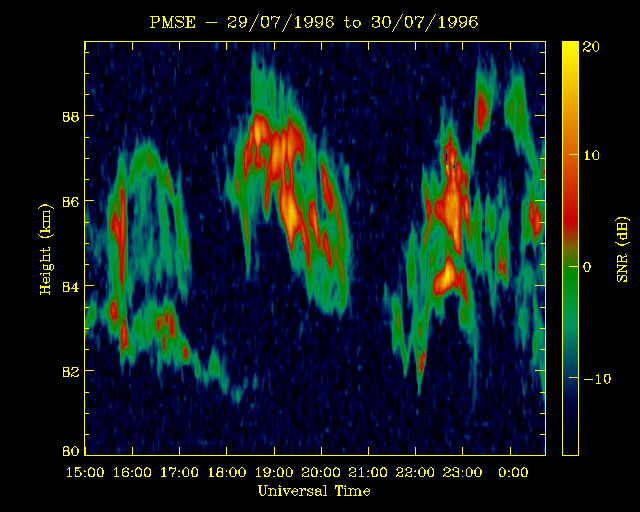
This figure shows the percentage of hours each day when the ESRAD radar detected PMSE in 1998 from day 140 to 240. PMSE is clearly a summer occurrence:

May 20th August 10
PMSE - diurnal variation:
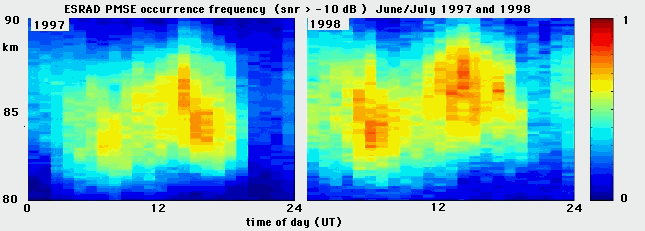
PMSE is seldom present between 21-01 local time and more common at higher altitudes during the after noon
Radiation angle, ground reflection and ground gain
The radiation angle is the angles where the transmitted signal and the signal from the ground image of the antenna are in phase. DX-ers on HF known, that the radiation angle of a horizontal beam is a function of its height over ground. At the radiation angle the signal may be enhanced by 5-6 dB of ground gain. The engineers in the 50ties took advantage of this ground gain by placing the antennas at the height giving the needed radiation angle. If you want this 5-6 dB you better know what you are doing. If you put your antenna up too high you might loose 10-15 dB at certain angles and it is likely you will make few QSO’s requiring this radiation angle.
The radiation angle is always higher than the elevation angle of the boom as long as there are ground effects.
The following radiation angles can be calculated for a QTH on a flat ground:
|
Beam height over flat ground in meters |
50 MHz |
144 MHz |
|
10 m |
9 º |
3 º |
|
20 m |
4 º |
1,5 º |
|
30 m |
3 º |
1 º |
|
40 m |
2 º |
0,7 º |
If the terrain is not flat quite a lot may happen to the radiation angle. If you have a hill in front of you, so the terrain is sloping upward the radiation angle will increase, clearly not good. However a downward slope will give lower angle of radiation. The required height of your tower is much smaller, when your QTH is on top of a hill, which is sloping gently right to the ocean or horizon in all direction. This is one of the main reasons for going /P to a hilltop.
Calculation of the radiation angle
The radiation angle from a QTH calculated by software. I know of the following packages doing this:
The angle of radiation for horizontal polarization is only dependent of the antenna height over reflecting ground. Using a vertical stack of two horizontal beams will concentrate the energy at the lowest radiation angle determined by the average antenna height, so stacking does not "pull down" the radiation angle. The radiation angle of the stack is the same as from one antenna mounted at the average antenna height, but the stack will put more power (say +2.5 dB) out at this angle. Vertical stacking of two beams will mean the average antenna height will be in the middle of the two beams, that is half the stacking distance lower than the upper beam. This means higher radiation angle than using the upper beam alone. Stacking requires a higher tower in order to get the same angle of radiation. If your situation is a fixed tower height consider, that stacking will mean more power in the lowest loop, which will be at a higher radiation angle than using just one antenna at the top.
If you want to know more on ground reflections, radiation angle and ground gain see my article in Scriptum der Vorträge 1998 p. 21.1-21.11 or at
www.qsl.net/oz1rh
Scatter
is composed of simultaneous reflections from many small objects. If all the resulting small signals arrive in phase at the RX the scatter is coherent and the signal quality is Q5. If all the small signals arrive more or less out of phase at the RX the scatter process is incoherent and the signal sounds distorted, much like aurora. Ionospheric forward scatter along a great circle bearing is almost coherent, so signal quality is OK as long as we use SSB or CW. If you want to make a data channel using ionoscatter you should however consider reading the books on ionoscatter and distortion, bandwidth and diversity reception. Selective fading could get you into troubles.You have no doubt hears that long distance troposcatter signals has a slight hollow "tropo sound" somewhat similar to a slightly aurora distorted signal. It is caused by incoherent scattering as the scatter angle is increasing. Likewise the shorter ionoscatter 900-1000 km signals I have heard on 50 MHz has this ‘DX-sound’ as the scatter angle is relatively high.
Sources with info on the current status of the ionosphere
The most important source of information on the ionosphere are MST radar’s, see a worldwide overview of MST radar’s at
http://www1.tor.ec.gc.ca/armp/king/radar/prof-urls.html. There is one in Wales which transmits on 46,5 MHz with 160 kW peak to a 104x104 m antenna with a beam width of 3,3 degrees. Such a radar can measure lots of things in the Mesosphere, Stratosphere and Troposphere (thus the name MST) and most important some of the results are available on the internet, check http://www.aber.ac.uk/~mstradar/ and www.nerc.ac.uk/nss/mst.html. The radar pictures shows that the scatter situation is often more complicated than the simple drawing I have presented above. Some of the radars provide an online picture of the ionization 80-90 km above the radar site. Here you can even see Es clouds and other forms of ionization, which could be useful for a QSO. Check http://www.irf.se/mst/MSTlatest.html as an example on this.This map shows all of the world's operational incoherent scatter radars. If you use the picture on
http://hyperion.haystack.edu/iswg/iswg.html you can access their WWW servers by clicking on the red dots or the site names.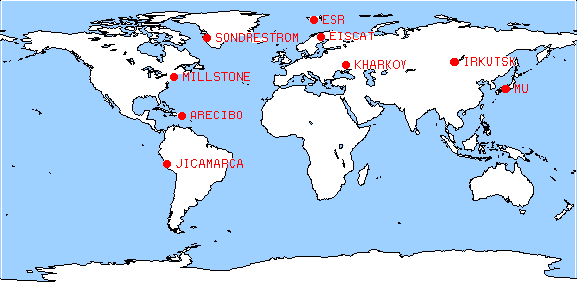 Scintillation:
Scintillation:
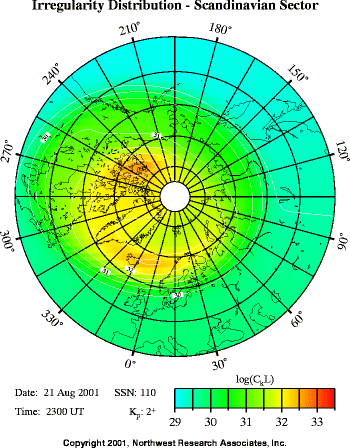
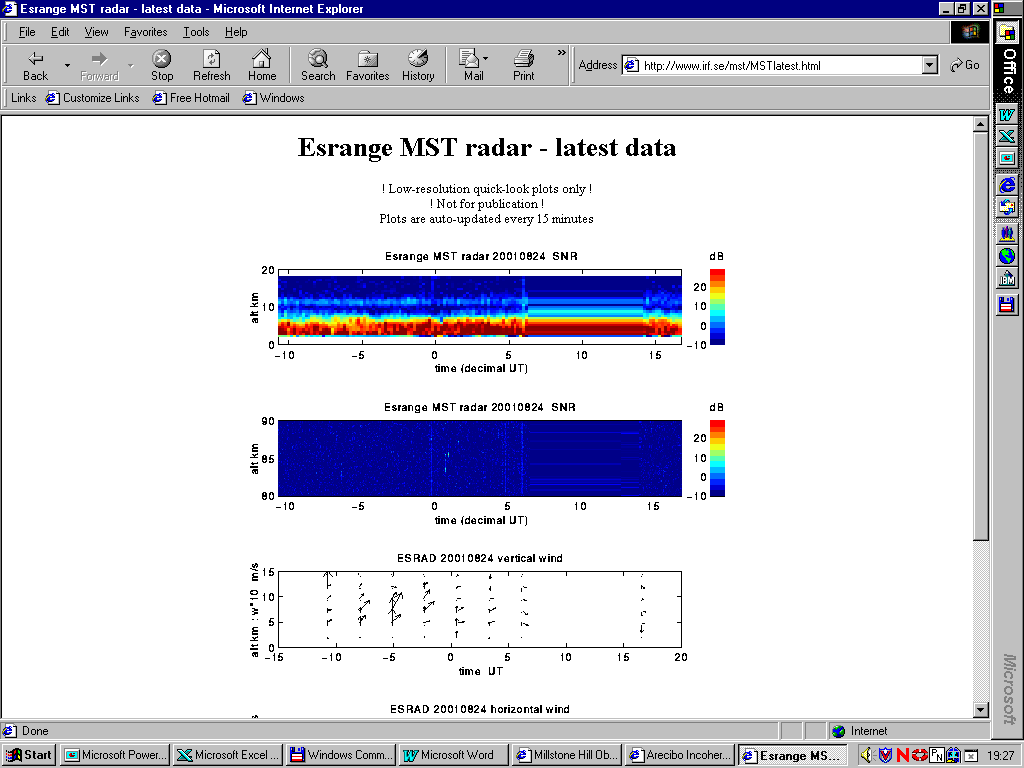 From
From
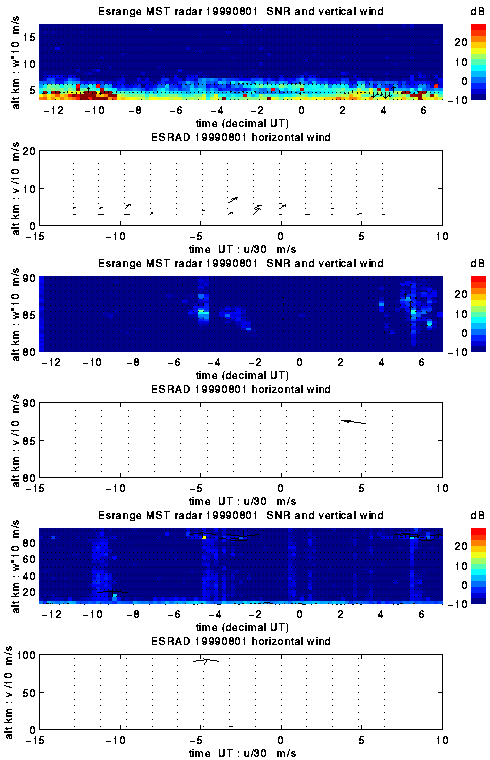
Here are some articles on ionoscatter I have studied with interest:
Kirby, R.C.,VHF Propagation by Ionospheric Scatter, and many other articles in Transactions of the IRE, Vol CS-4, No. 1, p. 17
The scatter propagation Issue: Proc. of the IRE, October 1955, p.1175-1298 ff.
Bowles, K.L., Ionospheric Forward Scatter, Annals of International Geo. Year, 3,4,1957, p. 346-360
E. Fich and R. Ruddlesden, "The choice of aerial height for ionospheric scatter links", Proc. IEE, vol. 105, pt. B, suppl. 8, January 1958, p. 12-18 <- the whole volume is 200 pages of interesting stuff on tropo- and ionoscatter
"Report of JTAC on Radio transmission by ionospheric and tropospheric scatter", Proc. IRE, January 1960
R.G. Merrill, "Optimum Antenna Height for Ionospheric Scatter Communication", IRE Transactions on Communications Systems, March 1960, p. 14-19
R.G. Merrill, "Radiation Pattern in the Lower Ionosphere And Fresnel Zones for Elevated Antennas Over a Spherical Earth", National Bureau of Standards Monograph 38, 1962
Bowles, K. L., G. R. Ochs, and J. L. Green, On the absolute intensity of incoherent scatter echoes from the ionosphere J. Res. NBS, Radio Propagation, 66D, 395-407, 1962.
Hagfors, Tor, On the Forward Scattering of Radio Waves in the Lower Ionosphere, J. Res. NBS, Radio Propagation, 66D, 409-418, 1962.
Folkestad, K. (ed.), Ionospheric Radio Communications, Plenum Press, New York, 1968
Grosskopf, Jürgen (1970), Wellenausbreitung I
CCIR XIIIth Plenary Assembly, Geneva 1974, Volume VI, Ionospheric Propagation, ISBN 92-61-00071-1, Rep. 259-3 VHF propagation by regular layers, sporadic E or other anomalous ionization and Rep. 260-2 Ionospheric-Scatter Propagation
Ince, A.N., Vogt, Williams, H.P., A review of Scatter Communications, AGARD Conference Proceedings No. 244, ISBN 92-835-0219-1, London 1978, 21-1
Davies, K., Ionospheric Radio, London, 1990, ISBN 0 86341 186 X, p. 470-476
Rohan, P. Introduction to Electromagnetic Wave Propagation, Artec House, Nordwood, MA, 1991, ISBN 0-89006-545-4, p. 194-195
Amateur literature:
Moynahan, Mark A., W2ALJ (now K3EE), VHF Scatter Propagation and Amateur Radio, QST, March 1956 (reprinted in Proceedings of the 34th Conference of the Central States VHF Society, IBSN 0-87259-805-5, ARRL order # 8055)
The World above 50 Mc, QST May 1967, p. 74-76
Hubach, Jan, OH1ZAA, D-layer Ionoscatter on 50 MHz, Six News, issue 30, June 1991
The World above 50 Mc, QST Feb 2000, p. 84
Liebmann, J.G., K5JL, Ionospheric Scatter, Proceedings of the 34th Conference of the Central States VHF Society, IBSN 0-87259-805-5, 2000 ARRL order # 8055, p. 34-35
A little advertising is coming your way also. My practical experience with ionoscatter comes from contesting where propagation can be judged. OZ5W/OZ9EDR contest team tries to make DX QSO’s regardless of band conditions, but we need someone at the other end to make a QSO. Please try looking for OZ9EDR or OZ5W in major contests and 19-23H local time:
1.st Tuesday of the month: 144.280 SSB/CW GU78b/8877/2x8874 2x18elm M2+2x9elm
2.nd Tuesday of the month: 432.180 SSB/CW 3CX800A 4x28elm
3.rd Tuesday of the month: 1296.180 SSB/CW OZ1BGZ 140 W at 4x37 elm JO65AP
4.th Tuesday of the month: 50.160 SSB/CW 2x8874 1kW 9elm /P JO55KR
We mostly have one beam to the south (DL and PA0) shortly after 19H local and to the northeast (SM and OH) around 21H local. Please exchange full 6-digit locator. We are in JO55UL or /P likely at JO64GX or JO55KR.
E-mail: oz1rh -at- oz1rh.comPhone: +45 46 78 77 67 GSM: +45 40 36 77 67 Fax: +45 46 76 10 67 Sri no packet, life is too short for QRP and 1200 bps! |
Snail: Palle Preben-Hansen Soderupvej 104 Aagerup Mill DK-4000 Denmark |
© OZ1RH